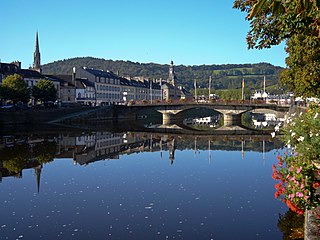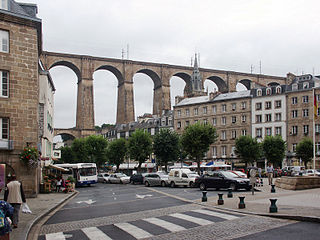
Eugène Freyssinet was a French structural and civil engineer. He was the major pioneer of prestressed concrete.

Plougastel-Daoulas is a commune in the Finistère department, located in the administrative region of Brittany, northwestern France.

The Plougastel Bridge, or Albert-Louppe Bridge, is a bridge over the river Élorn near Brest, France, connecting Plougastel-Daoulas and Le Relecq-Kerhuon.

Châteaulin is a commune in the Finistère department and administrative region of Brittany in north-western France. It is a sub-prefecture of the department.

The arrondissement of Brest, sometimes referred to as greater Brest, or the greater Brest region, is an arrondissement of France in the Finistère department in the Brittany region. It has 77 communes. Its population is 374,276 (2016), and its area is 1,396.2 km2 (539.1 sq mi).

Plogoff is a commune in the Finistère department of Brittany in north-western France.
The Route nationale 165 is a highway in Brittany. It connects the towns of Brest and Nantes. It is also numbered European Route 60. The majority of the route is autoroute standard.

Landerneau is a commune in the Finistère department of Brittany in north-western France.

The Chemin de fer des Côtes-du-Nord, the Côtes-d'Armor today, was a 1,000 mm, metre gauge, railway in Côtes-du-Nord, France, although there were a few kilometres of line in Finistère and Ille-et-Vilaine. The first lines opened in 1905 and final closure was in 1956. The lines were a voie ferrée d'intérêt local system with a total extent of 457 kilometres (284 mi).
The Réseau Breton (RB) is a 1,435 mm, standard gauge, and former 1,000 mm, metre gauge, railway in Finistère, France, with a few kilometres of line in Côtes d'Armor, Ille-et-Vilaine and Morbihan. The hub of the system was Carhaix. The metre gauge lines were built with the capacity to be easily converted to standard gauge if necessary.

Brest Métropole is the métropole, an intercommunal structure, centred on the city of Brest. It is located in the Finistère department, in the Brittany region, western France. It was created in January 2015, replacing the previous Communauté urbaine de Brest. Its population was 215,367 in 2019, of which 142,555 in Brest proper.

The railway from Paris to Brest is a 622-kilometre long railway line in France that connects Paris and the western port city Brest, via Le Mans and Rennes. It is used for passenger and freight traffic.
Le Télégramme is a French-language daily newspaper from the Brittany region of France, based in the commune of Morlaix. It was founded in 1944 and still exists to this day, although circulation has been declining since 2012.

The Pont de l'Iroise is a cable-stayed bridge in Finistère, Brittany, France, which spans the Élorn river where it enters the roadstead of Brest. It carries route nationale 165, the road between Brest and Quimper, and connects Le Relecq-Kerhuon to the north with Plougastel-Daoulas to the south. The bridge is named after the Iroise Sea, into which the roadstead of Brest opens.
Kristian Hamon is a Breton and French historian whose work focuses on collaboration in Brittany during World War II.

Joseph Romain-Desfossés was a French naval officer and politician. He was appointed Minister of the Navy and Colonies on 31 October 1849.

Hélène Vitivilia Leune, also known by the pen name Lène Candilly, was a French writer of Greek origin, traveler, war correspondent, and decorated Red Cross nurse.
The following is a timeline of the history of the city of Brest, France.
The parish close of Plougastel-Daoulas in northwestern France comprises the Saint Pierre church, an elaborate calvary and a war memorial. The calvary at Plougastel-Daoulas is a listed historical monument since 1889.
Léopold Maissin was an engineering graduate of the École Polytechnique and industrialist who also became a politician. He served for many years as the mayor of Le Relecq-Kerhuon, a small coastal municipality in the extreme north-west of France. In 1889 he was elected to the departmental council, representing the canton of Landerneau. In 1904 he was elected vice-president of the Departmental council for Finistère. His electoral fortunes were otherwise mixed, but he retained his mayoral position till 1914, at which point he was succeeded in the post by his son.














